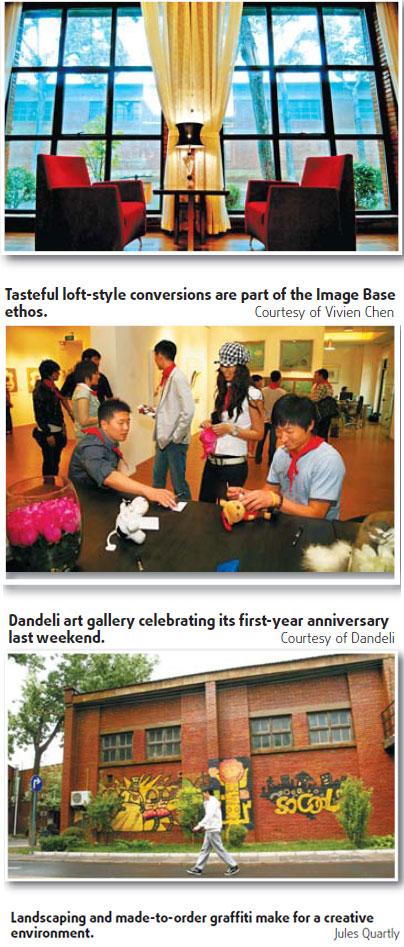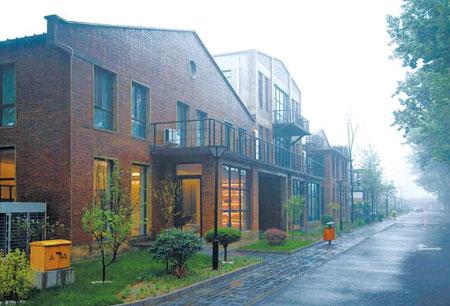By Jules Quartly
Once Beijing Textile City populated by factories and warehouses, Image Base is
now all designer spaces for culture-based industries.
Build it and they will come, appears to be the motto of Beijing's planners. From Olympic stadia to super malls and the landmark CCTV tower, ambitious projects are being realized at a bewildering pace. After the tearaway success of the 798 Art Zone comes another commercial culture center, Image Base.
Known locally as Jing Yuan, the Chaoyang district site captures an important time in Beijing's planned economy during the early years of New China, before the opening-up and reforms of 1978. The area used to be known as "Beijing Textile City" and was a center for cotton, hemp and rubber, populated by factories and warehouses.
In what is a sign of the times, these are now designer spaces for culture-based industries such as photographic studios, movie or other media offices, and the occasional swanky art gallery. Cartoon, film and documentary makers have moved in; glassmaker Tittot has its Beijing headquarters here; as do fashion and advertising groups.
Image Base management reports about 85 percent of its 48 warehouse units have been leased since it opened to the public in July last year. Currently, the park occupies about 10 hectares, including 6 hectares of floor space. Another parcel of land nearby has also been earmarked for further expansion.
"Development has been really quick," says General Manager Du Sanyong, who says this is where the business of art is conducted. "The city government supports us while the central government emphasizes the importance of cultural industries, the China brand.
"Here we produce many art-based products. Creative companies like us because we are in a better environment and with cheaper rents than a place that is established, like Soho (Beijing)."
Although Image Base is in the Central Business District, it is outside the Fourth Ring Road, surrounded by urban blight and renewal in roughly equal measure. The nearest underground station is 2 km away at Shuangjing and even local taxi drivers scratch their heads when given the address on Guangqu Road.
A kind of tribal pole that is illuminated red at night announces your arrival and the obligatory private security guard waves you through. A couple of restaurants and bars greet you next, plus the main exhibition warehouse, the venue for events like the unveiling of sports cars and electronic products.
Roads are newly blacktopped and the warehouses have been tastefully renovated, with varnished brick and stunning skylights. Money has been spent on landscaping and the graffiti is made to order, making it a pleasant environment to walk around.

Director Hsu Hsiao-ming, who has a suite of offices for his movie production company, reckons it's prettier than 798. He was one of the first to move in and was inspired by Shanghai's Suzhou Creek and Yangpu artist districts. His vision for Image Base is linked to the development of the country's culture industries.
"Beauty and fashion is dominated by the United States and Europe, but China is becoming more wealthy and as people get richer so the definitions of beauty and fashion will evolve and shift to China. This is a process, an evolution," Hsu says.
"Currently, when the world looks at China it thinks of traditional culture. But the new generation has fresh influences, particularly from the West. There is therefore a new synthesis, products, culture and cultural convergence."
Kalley Chen, a lawyer who celebrated the one-year anniversary of her Dandeli art gallery at Image Base last weekend, emphasizes the importance of culture to continued financial growth.
"When you have a strong economy you must also have a strong culture base because you need to keep your core values and support ongoing growth. If not, it would be like a large company without corporate culture, or a child growing up without values."
She says she was drawn to Image Base partly because it is in a conservation area. She believes it's necessary to move with the times, but also important to preserve history.
"A lot of things, like hutong, are being sacrificed to progress as the city is being built," she laments. "There is a price to pay when cities grow this quickly. We should make an effort to preserve and create spaces to sit and talk and have a social life. Loft design is like a comfort zone."
Chen likens Image Base to a garden, saying that culture is soil for economic growth and that Image Base enhances land value, both monetarily and in terms of intangible assets. "It is a place where new talent is cultivated," she says.

But not everything is a bed of roses in the Image Base garden. Its opening was overshadowed by the Olympics and there has been little or no press coverage. Google it on the Internet and you will find just a handful of references. Unlike 798 there are relatively few visitors, the exhibition hall is rarely used and although some warehouses are leased, they are not occupied.
Some of the business owners at Image Base are dissatisfied with this state of affairs. There could be more people and a bigger buzz about the business park, they say, calling on management to market it better and put on events, like festivals.
Photography studio head Vivien Chen says Image Base has helped realize his creative and commercial dream of building a cool commercial studio flooded with natural light. Even so, he says the zone is suffering "growing pains".
Image Base is primarily State owned, but the structure is complicated. Baiziwan Warehouse, a cotton and hemp products company, partnered with newspaper First Daily to establish Image Base in 2007. The Dongfang Xinjie Jing Yuan culture company was formed to manage the project, which in turn sublet half the area to a developer, San Dong.
Some of the developer's tenants are sitting on their empty properties, waiting for land values to go up further, Chen says, adding that rents have already tripled, from 1 yuan a sqm to 3 sqm per day.
"This could discourage young artists and favor established businesses with no artistic credentials," Chen says. "I hope this will be a creative area like 798 but I am worried about lost opportunities and not developing our potential."
Image Base manager Du Sanyong, however, insists the site is already a success and points to the popularity of the units. While many warehouses are empty, most have been rented and will soon be occupied. Rents, he adds, are still cheap compared with other locations that do not have the same selling points.
He admits the Olympics and now the global economic crisis have curtailed expansion but says management has been working hard to market Image Base and tenants are also responsible for holding events and creating publicity. Creative industries are not just run by artists, Sanyong adds, they include advertising agencies, publishers, design, picture trading and other related technical services.
"Lost opportunities" notwithstanding, Chen is in for the long haul and hopes Image Base will be a home for creative types that will spearhead China's cultural industries.
"The government is right - this is a good time to develop culture industries," Chen says. "I think the best of China is among the best in the world. Maybe Americans and Europeans don't think so but that doesn't matter so much any more because this market is becoming so big that it will dictate demand in the future".
Source: China Daily
http://www.chinadaily.com.cn/cityguide/2009-05/14/content_7776362.htm









